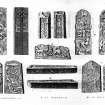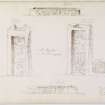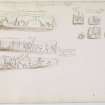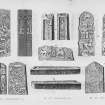Pricing Change
New pricing for orders of material from this site will come into place shortly. Charges for supply of digital images, digitisation on demand, prints and licensing will be altered.
Upcoming Maintenance
Please be advised that this website will undergo scheduled maintenance on the following dates:
Thursday, 9 January: 11:00 AM - 3:00 PM
Thursday, 23 January: 11:00 AM - 3:00 PM
Thursday, 30 January: 11:00 AM - 3:00 PM
During these times, some functionality such as image purchasing may be temporarily unavailable. We apologise for any inconvenience this may cause.
Meigle
Grave Slab (Early Medieval)
Site Name Meigle
Classification Grave Slab (Early Medieval)
Alternative Name(s) Meigle Museum; Meigle Stones; Meigle No. 9
Canmore ID 30869
Site Number NO24SE 25.09
NGR NO 2872 4459
Datum OSGB36 - NGR
Permalink http://canmore.org.uk/site/30869
- Council Perth And Kinross
- Parish Meigle
- Former Region Tayside
- Former District Perth And Kinross
- Former County Perthshire
Meigle 9, Perthshire, recumbent gravestone
Measurements: L H 0.31m to 0.23m, L 1.80m, W 0.33m to 0.20m
Stone type: sandstone
Place of discovery: NO 2872 4459
Present location: Meigle Museum.
Evidence for discovery: drawn by Pennant in 1772 in the churchyard.
Present condition: very worn.
Description
The presence of a bar socket (L 0.19m, W 0.08m, D 0.06m) for an upright at the wider end of the slab suggests that this is the head of the monument. The foot of the monument is now higher than the head, but the upper surface, face A, has been much reduced by wear or trimming, possibly for re-use as a graveslab. Pennant’s illustration shows a sunken panel within an ornamented border in the top of the stone. Both end panels, faces C and E, are plain, but the long sides, faces B and D, are carved in relief.
Face B is bordered and divided into six panels by roll mouldings. The panels are of different sizes and contain, from the left, a quadruped walking to the right, a seated human figure facing left whose legs are entwined with those of a contorted stork-like bird, another quadruped facing right with tail curling up over its back, a panel of spiral work, a very worn panel with figures and finally a plain panel with possible. Long face D is bordered and divided into five panels by roll mouldings. From the left, after a plain panel, the other panels display a winged griffin facing left with a bird hanging from its mouth, a panel with a circle of interlace, a quadruped facing left with an elongated body entwined round itself forming a knot and spiral joints, and two confronted quadrupeds whose jaws are grasping one another (or possibly the head of the left-hand animal is inside the jaws of the other). Their elongated tails form clouds of interlace above their backs, and their bodies are outlined by a fine internal line.
Date: tenth century.
References: Pennant 1776, vol 2, pl 17; RCAHMS 1994, 100, B.
Desk-based information compiled by A Ritchie 2018.
Publication Account (1964)
Recumbent grave-stone: on one side are five panels; a beast; a bird seizing a man by the neck; an elongated beast; a panel of spiral work; traces of two men. On the other side four panels; a gryphon carrying an animal; a beast interlaced in its own body; a pair of facing animals with a single head. The upper surface is slotted for an upright cross.
S Cruden 1964
Note (1990)
NO24SE 25.9 2872 4459.
This recumbent grave-slab, measuring 1.8m in length by up to 0.33m in width and 0.3m in thickness, decreases in both thickness and breadth from the head of the stone to the foot. Towards the head of the slab there is a socket, presumably for an upright cross (0.19m by 0.8m and 0.06m deep); a decorated raised border on this face could still be seen in the eighteenth century and is illustrated by both Pennant and Skene, but has now been worn away. On each side of the slab there are panels of decoration, now very worn. On the left-hand side there are four panels divided by upright bead-mouldings: at the head, there is a gryphon with what may be a bird in its beak; a panel of encircled interlace; a beast with an interlaced body; a pair of opposing beasts with areas of interlace forming their tails, and possibly interpreted as sharing a single head. On the right-hand side there are five panels: an animal; a bird and a man with legs interlaced, the bird biting the man's neck; a beast with a curled tail; a panel of spiral ornament; and, at the head, there are worn traces of two figures.
Information from RCAHMS (JNGR) 1990.
T Pennant 1776; Skene SAS 464.














































